~ continued from page 1 ~
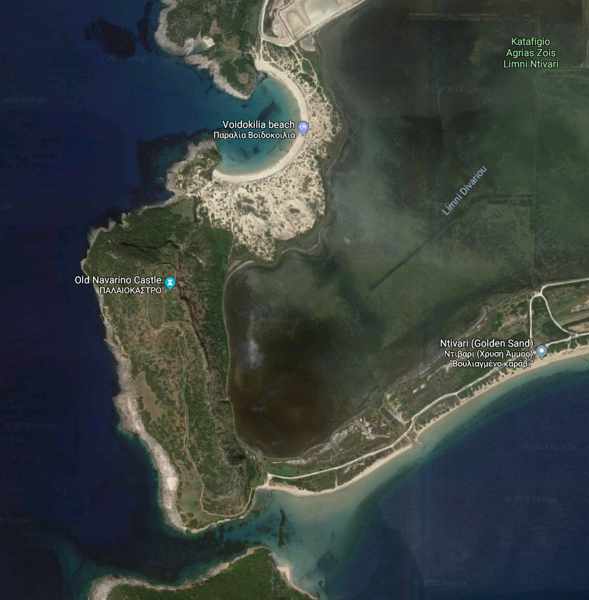
A Google aerial photo shows the Old Navarino Castle location atop a 200-meter hill between Voidokilia beach (top) and Divari beach (bottom right)
This video by Ilios Iliopoulos features aerial views of Palaiokastro, including the formidable sheer cliff it on its eastern flank
I had read that there are two ways to reach the Palaiokastro on foot. The most popular and supposedly easiest route is accessed from the end of Divari beach, while an apparently much more difficult trail starts at the top of the dunes at the eastern end of Voidokilia beach. We chose to walk up from Divari.
The hike starts on a dirt road that leads uphill from the beach and eventually transitions into a narrow foothpath that winds through grasses, shrubs and overgrown weeds all the way to the castle entrance. The lower section of the path offers lovely views of Divari beach, Sfakteria Island, and the channel between Sfakteria and the mainland. As the trail turns north toward the castle, scenery includes a wide open slope blanketed by wildflowers, grasses and thousands of tall flowering plants; the rocky coastline below; and the vast expanse of the striking blue Ionian Sea.
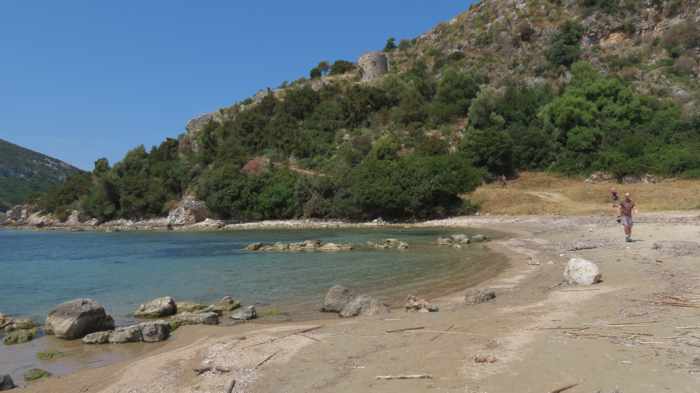
The main trail to the Old Castle of Navarino starts at the northwest end of Divari beach (above), which I profiled in my recent post The quiet end of Divari, the mile-long golden beach in Messenia. A more difficult trail to the castle can be accessed from Voidokilia beach.
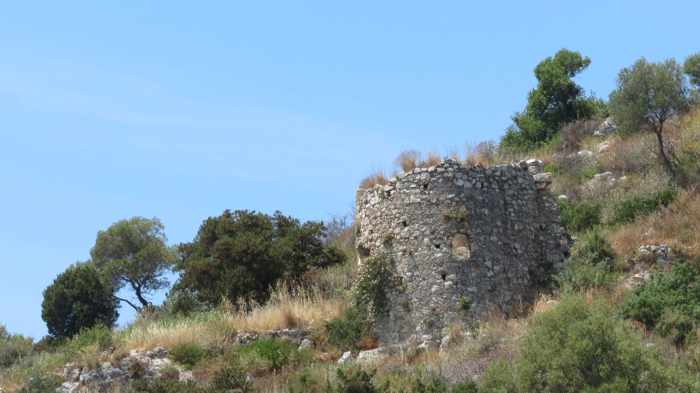
The ruins of a tower that once guarded the access path to the castle are visible from Divari beach
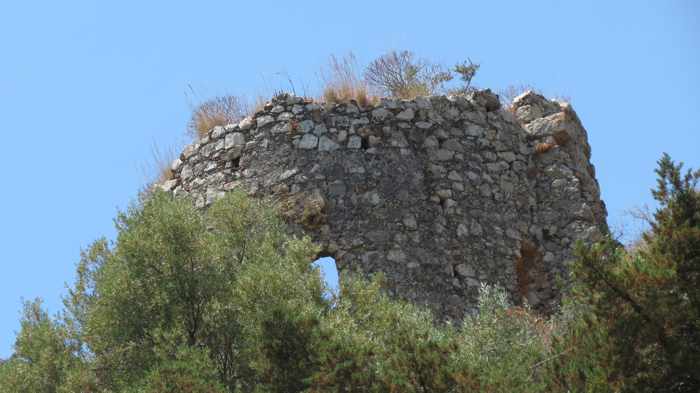
The old tower ruins above Divari beach
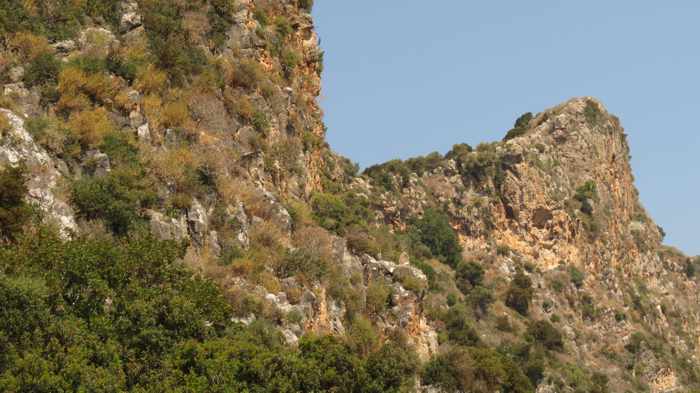
Sheer cliffs face Navarino Bay and the Gialova lagoons on the east side of the castle hill, providing a natural defence from invaders
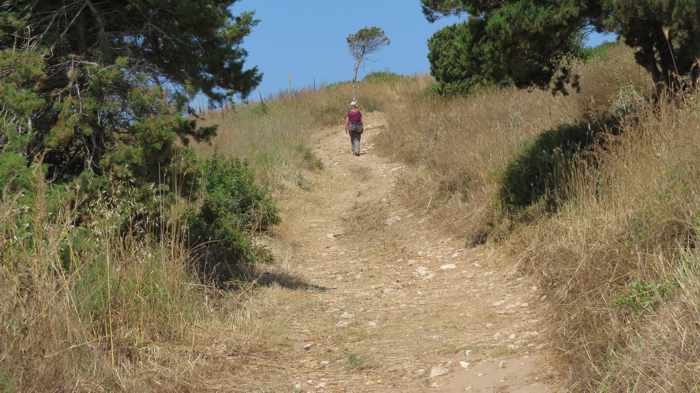
The castle path starts along this road from Divari beach …
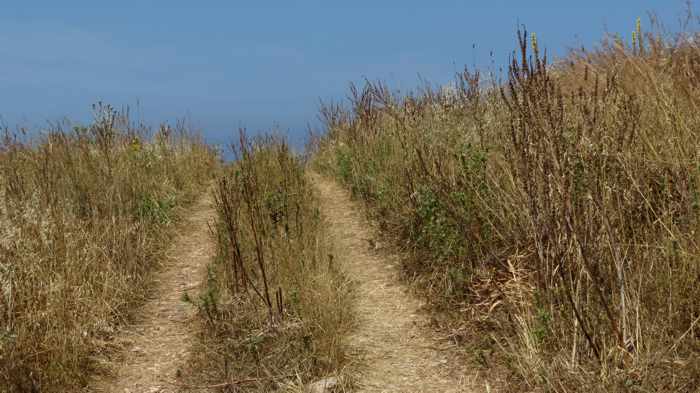
… and progressively becomes narrower and overgrown with weeds and plants

The lower path overlooks Divari beach …
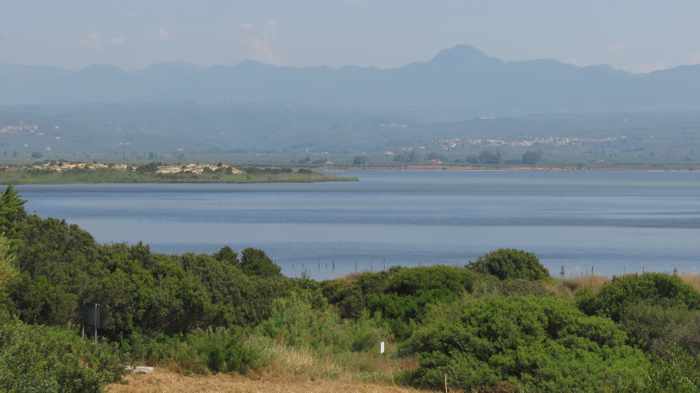
… has beautiful of Navarino Bay and mountains in the distance …
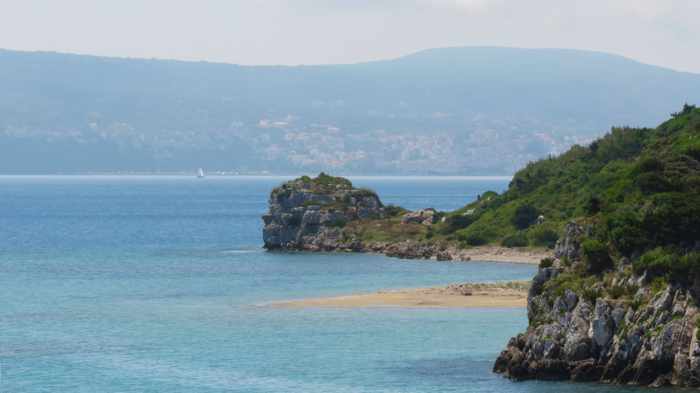
… and includes views of Glossa beach on Sfakteria Island, and the town of Pylos across the bay
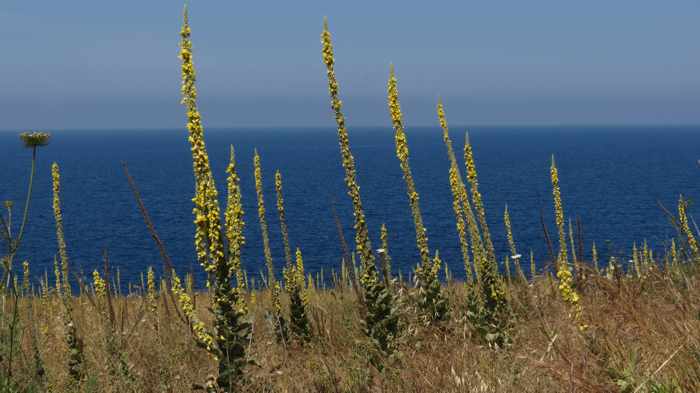
Thousands of tall flowering plants lined the hillside between the trail and the Ionian Sea
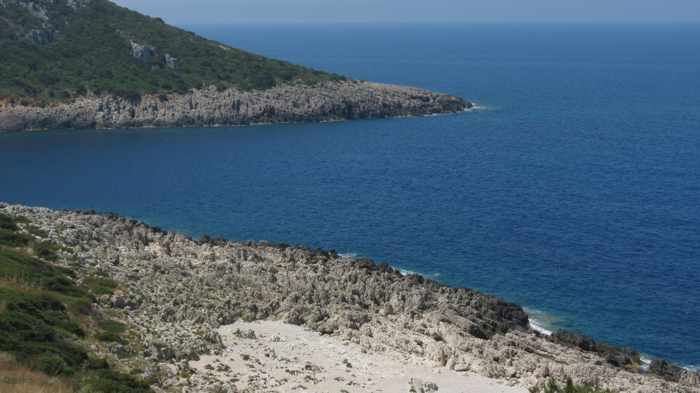
Sfakteria Island (top left) and the rugged, rocky coast below the castle path
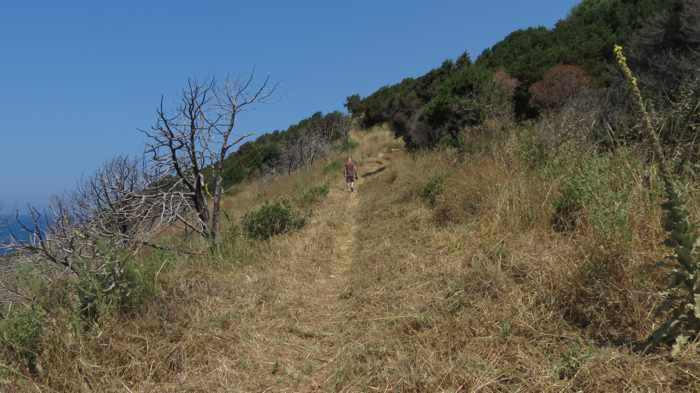
The path gradually gets steeper, but isn’t difficult to walk at this point. It’s a different story right below the castle, where you have to walk over heaps of stone from collapsed wall segments to reach the entrance.
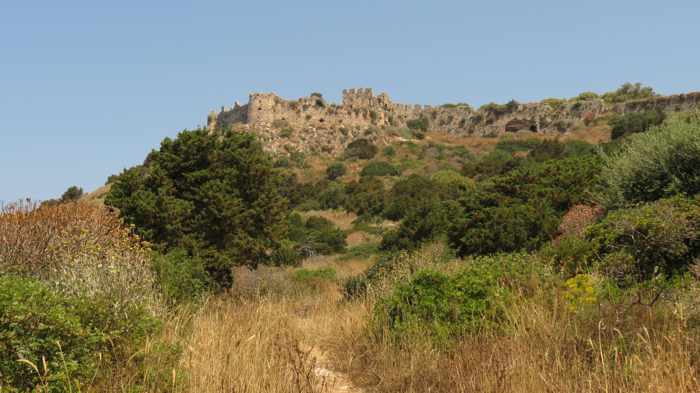
As the castle comes into view, the trail disappears into tall grasses and shrubbery on the hillside
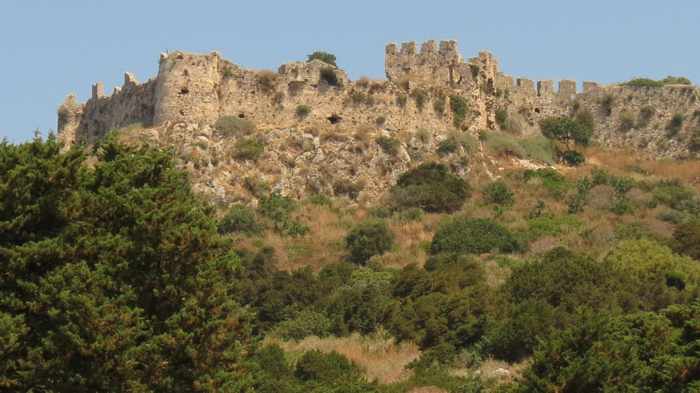
The south wall of Palaiokastro looms closer
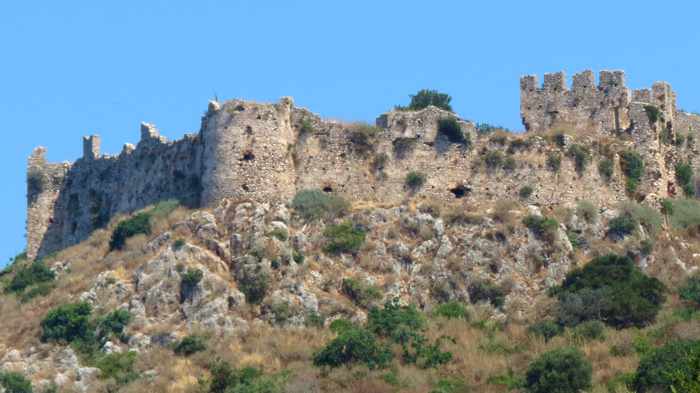
Most of the outer castle walls are intact, but some sections have partially caved in or completely collapsed
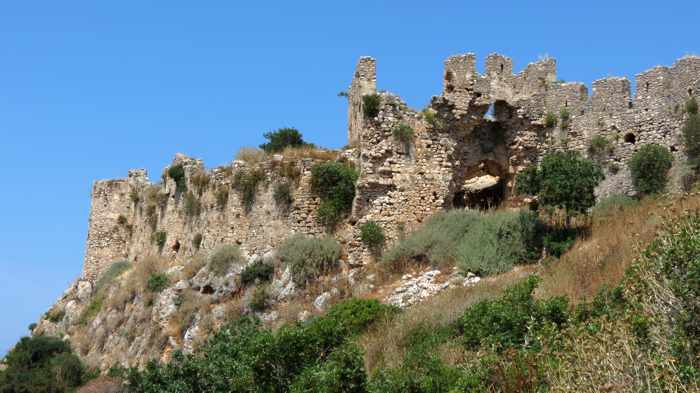
Approaching the entrance portal on the southern castle wall
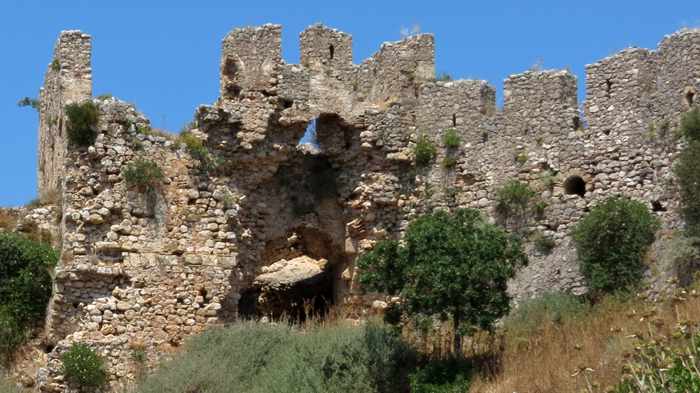
The castle entrance is one of the places where large sections of wall have crumbled and collapsed
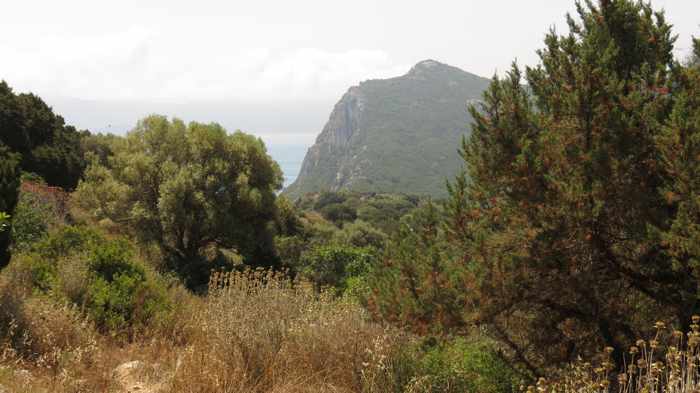
Looking down the route we had just climbed, from a vantage point near the castle entrance. The trail is obscured by the trees and thick bushes.
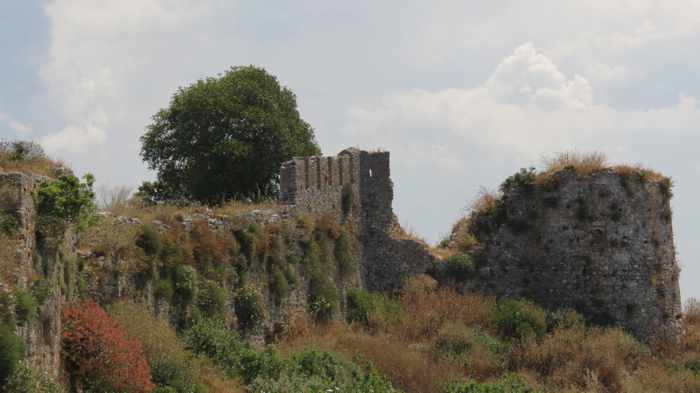
The wall and a round tower on the southern side of the Palaiokastro
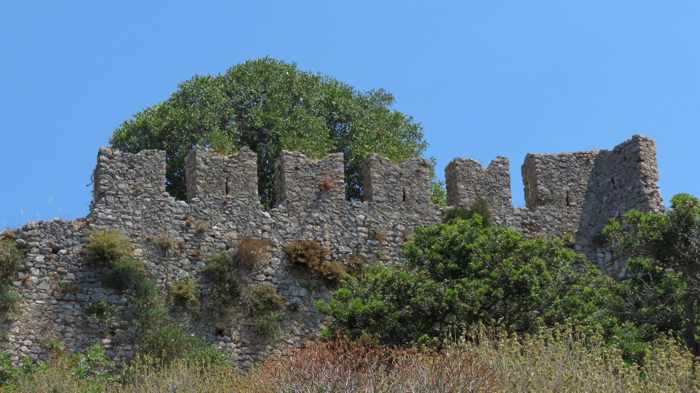
A crenellated segment of the southern wall
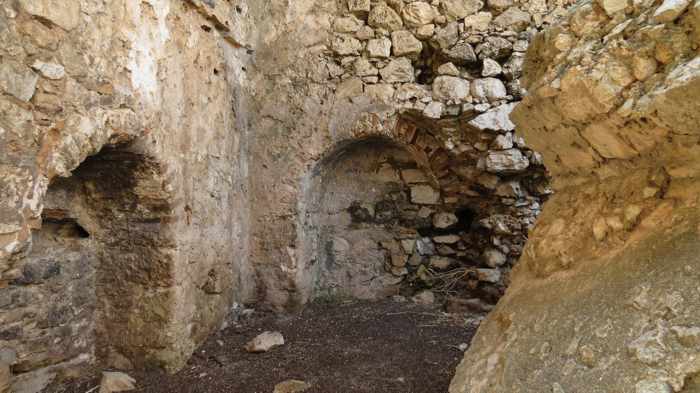
A passageway inside the castle entrance
Once inside the castle, we had two options: Follow a trail directly to the eastern wall for the views of Voidokilia, or take a walk atop the western wall. We decided to walk the wall first, and located a crumbling set of steps leading to the top. As one could imagine, the views from there were amazing, and it felt exhilarating to walk along the ancient structure towering so high above the Ionian Sea.
It was very breezy, however, and that made the walk particularly challenging and even frightening at times. Although much of the narrow path is sheltered from the wind by thick crenellated stone walls standing about two meters tall, those battlements have collapsed in places, leaving the trail totally exposed to the wind. It’s unnerving enough to walk past these open spaces when the wind is calm, since there’s a steep drop to the sea on one side, and a two-meter drop to the rock- and bush-covered castle yard on the other. But it’s downright scary to get caught crossing one of these spaces when the wind suddenly blasts — there’s absolutely nothing to grab onto if you lose your balance.
I had a couple of close calls in which I briefly lost my footing in strong gusts of wind, but luckily managed to keep from falling. Nevertheless, images kept flashing through my mind of how horrible it would be to tumble off the wall and break a limb or suffer some other serious injury. Perhaps needless to say, those thoughts detracted a bit from my enjoyment of the walk, but they did add to the excitement and made this part of our hike rather unforgettable.
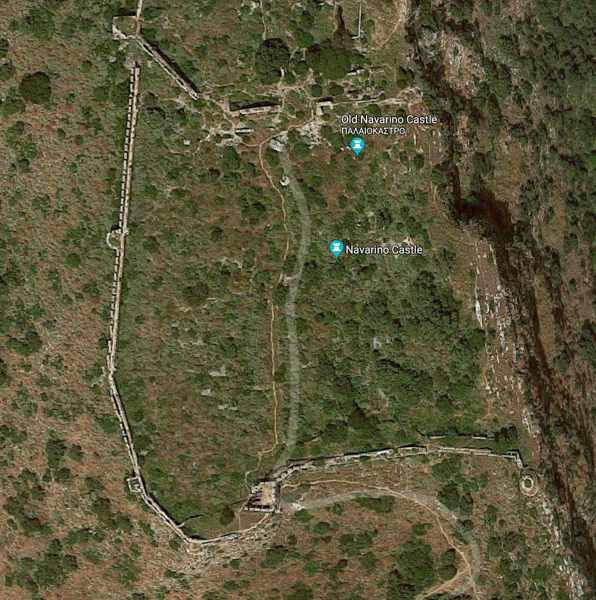
A Google aerial photo shows the western wall (left) and a trail (center) that leads from the castle entrance to the northern part of Palaiokastro, which is the site of an ancient acropolis and the original Navarino fortress. The fantastic views of Voidokilia beach are observed from various locations in the northeast section of the castle grounds.

View to the east from a lookout point atop the castle wall
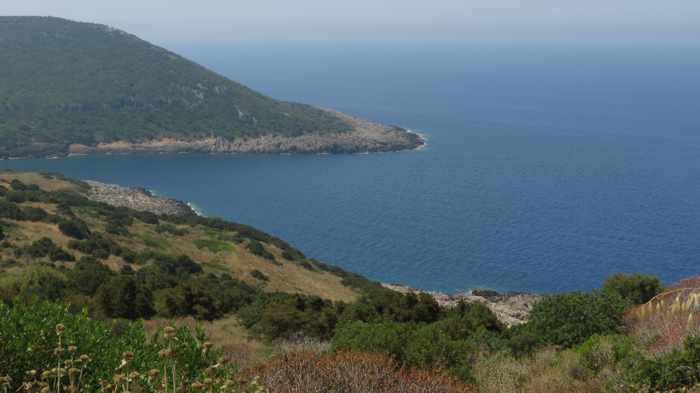
Castle wall view of Sfakteria island and the coast below the fortress
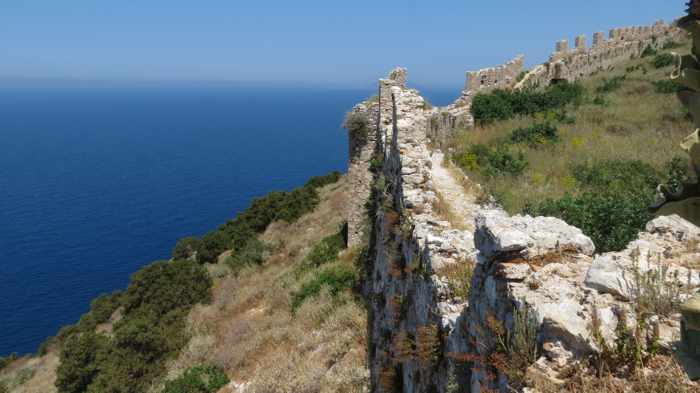
View of the Ionian Sea from atop the castle’s exterior wall
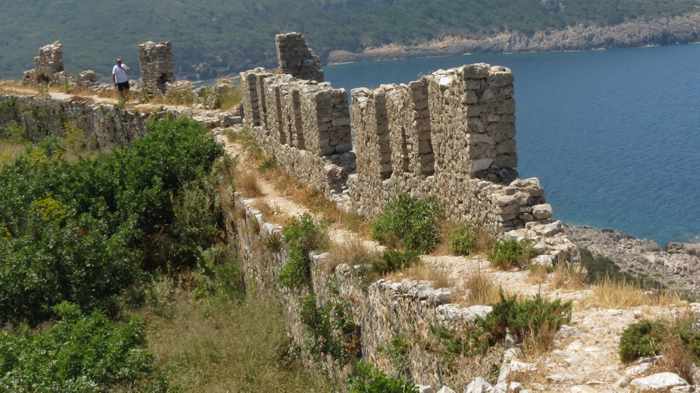
Crenellated battlements shield most of the narrow footpath from the wind, but in numerous places the walls have completely or partially collapsed, leaving the trail totally exposed on both sides. I wouldn’t recommend walking the wall if you suffer vertigo or have a fear of heights!
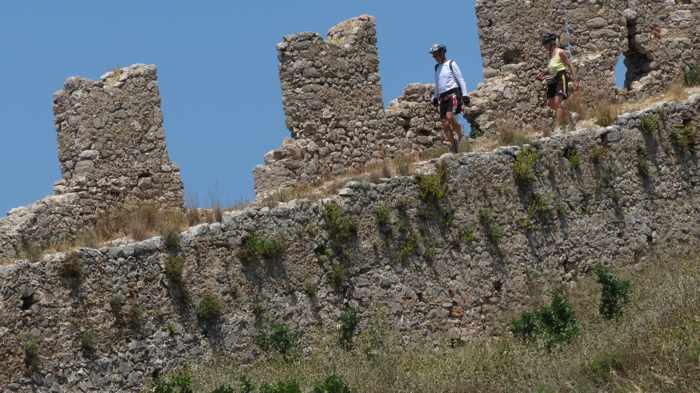
Visitors walking along the top of the western wall
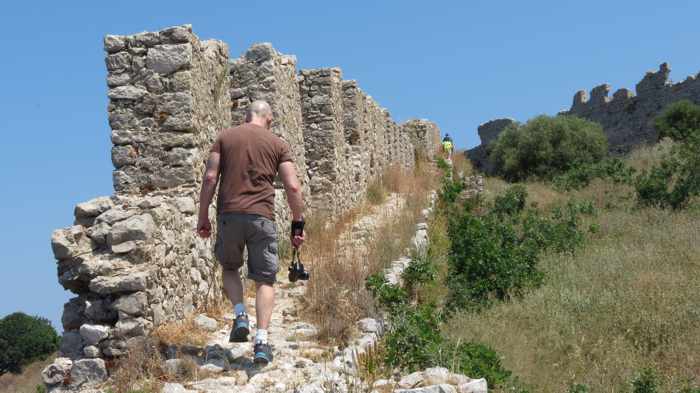
We didn’t realize that the walkable section of wall ended just a few dozen meters past this spot. We had mistakenly believed the path would continue either along or beyond the interior transverse wall at top right.
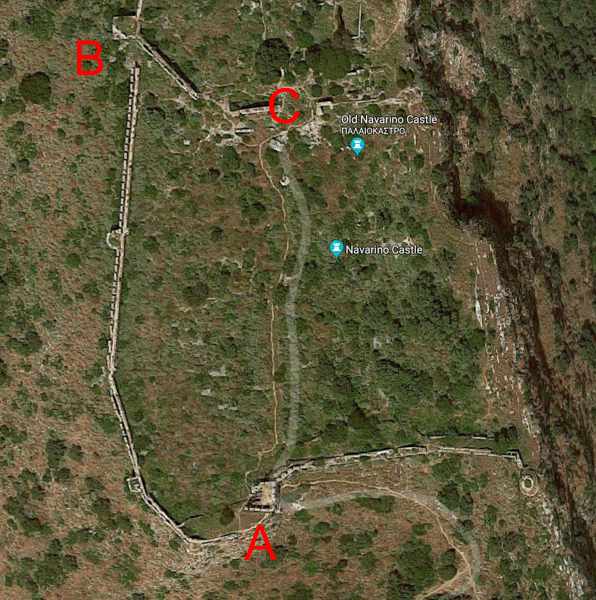
We started our wall walk at the point I marked as “A” on this photo from Google. The walkable section of the wall dead-ends at the spot marked “B.” Point “C” is the entry to the north section of the Palaiokastro, from which visitors can reach the lookout spots above Voidokilia beach. We didn’t feel like retracing our steps from Point B to Point A, and thought it would be simple to take a shortcut across the castle yard to reach Point C. That was a big mistake: We couldn’t find a path, and had a hellish time making our way over a mound of wobbly boulders and through twiggy shrubs and thorny bushes.
Our wall walk ended abruptly when the couple ahead of us turned around and said they had reached a “dead end.” Sure enough, it wasn’t possible to go any farther. We didn’t want to backtrack along the wall, so we looked for a shortcut to the east side of the castle. We noticed that the man and woman we had just spoken to were making their way eastward through the yard, so we assumed they had located a trail. We decided to go that way, too.
We found the steps the pair had used to climb off the wall, but once we got down we couldn’t find any pathways. The couple was just a few meters ahead of us, weaving through the bushes on what appeared to be a short uphill slope, so we started to follow. But we quickly discovered that we weren’t walking on solid ground; it was a heap of loose rocks that originally may have been walls of a building that had collapsed. The large stones shifted and slid with each step we took, and it was a challenge to move forward without slipping or tipping off balance. Making matters worse were the tangles of shrubs, thickets and thorny weeds growing between the stones. We were both wearing shorts and short-sleeved shirts, and It was virtually impossible to avoid getting our legs and arms scraped by twigs and branches. We considered turning back and returning to the wall, but since it looked like we had already gone more than halfway, we persevered and continued onward. I couldn’t begin to count the number of times I almost fell, nearly twisted an ankle, or got scratched by a branch. I cursed and swore constantly, repeatedly asking myself what I had been thinking when I decided to follow the other people. The scene must have looked hilarious to anyone who may have been watching us fumble along, but I didn’t find it funny at the time. (I do chuckle about it now, though).
To our tremendous relief we reached a proper path and emerged with scrapes and scratches as the only battle wounds from our foolish foray through the brush and over the rocks. We followed the trail into the north castle grounds, where we encountered several people coming our way. One said it wasn’t much farther to reach the Voidokilia lookout, and she pointed to show us the way. But her recommended route led us through another boulder-filled yard where the trekking once again became tricky and uncomfortable. Here, at least, there weren’t many shrubs, so we didn’t have to worry about twigs scraping our bare legs as we gingerly stepped to the east side of the castle. We saw several other people carefully making their way over the rocks, and we passed one fellow who was resting in the shade of a tree. “Are you having any fun yet?” I asked. He shook his head. “This isn’t fun at all!” he muttered.
Close by we discovered a large opening in the wall through which we had excellent views of the Gialova lagoons, Navarino Bay and surrounding countryside. A little farther along we were able to climb to the top of another wall from which we could enjoy the jaw-dropping views of Voidokilia we had seen in travel photos and videos. It seemed surreal to be standing there, overlooking such spectacular scenery. The rolling green hills and mountains of the Peloponnese, the extensive Messenian coast, and of course the almost perfectly semicircular Voidokilia beach all looked even more breathtaking in person than I had anticipated. Photos and aerial videos simply can’t capture the full sensory impact and thrill of seeing such striking landscapes with your own eyes.
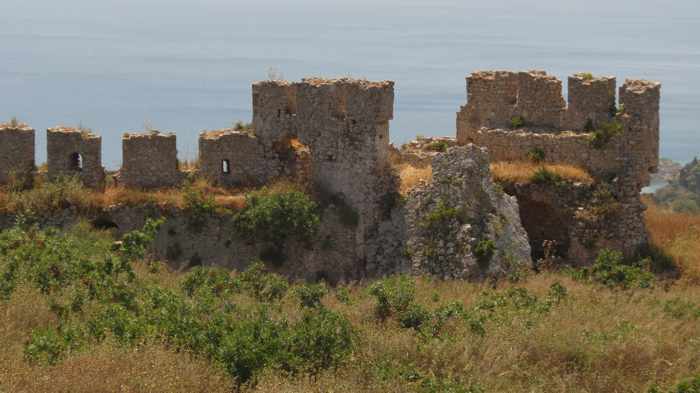
A section of wall on the eastern side of the Palaiokastro
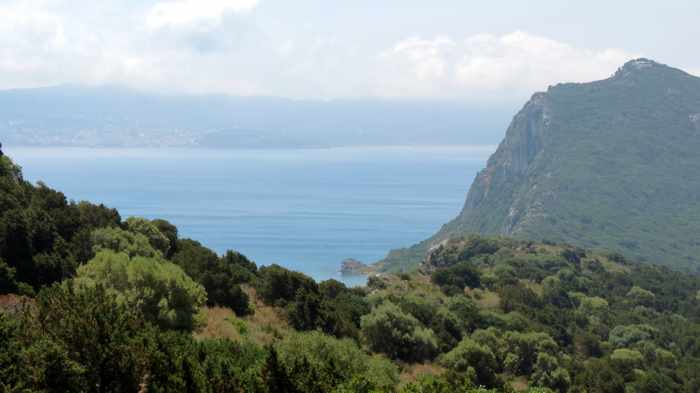
Castle view of Sfakteria Island (right) and Navarino Bay
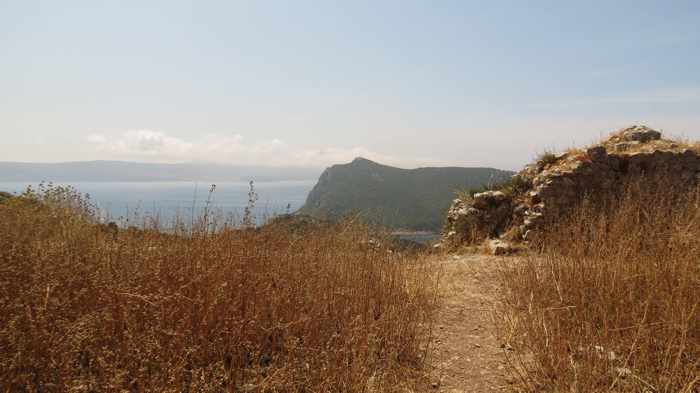
View from the trail leading into the north yard of the Palaiokastro
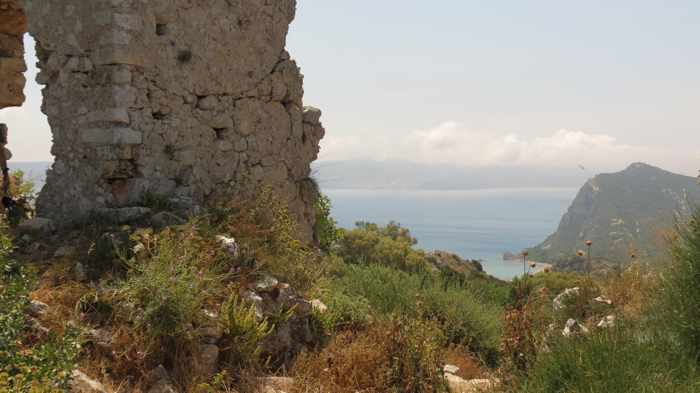
A section of castle wall and a view of Navarino Bay
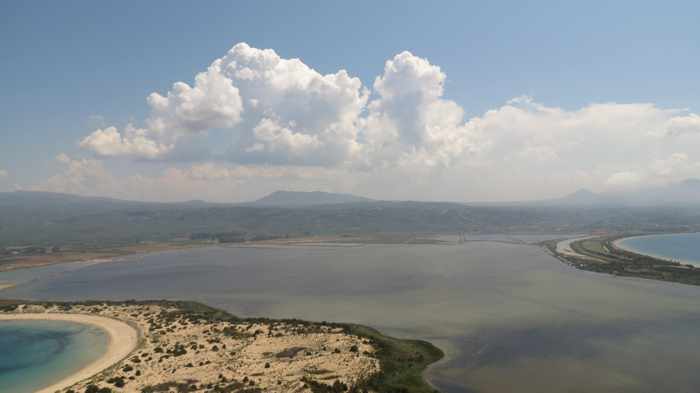
Castle view of Voidokilia beach (lower left corner), the Gialova lagoons, and Navarino Bay (far right)
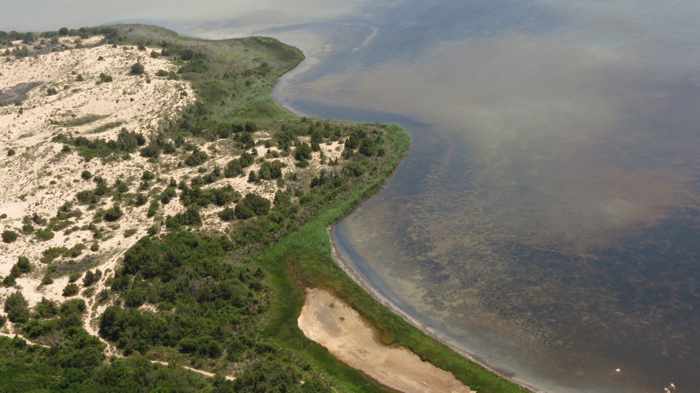
Dunes behind Voidokilia beach (left) and part of the Gialova lagoons, an environmentally protected area
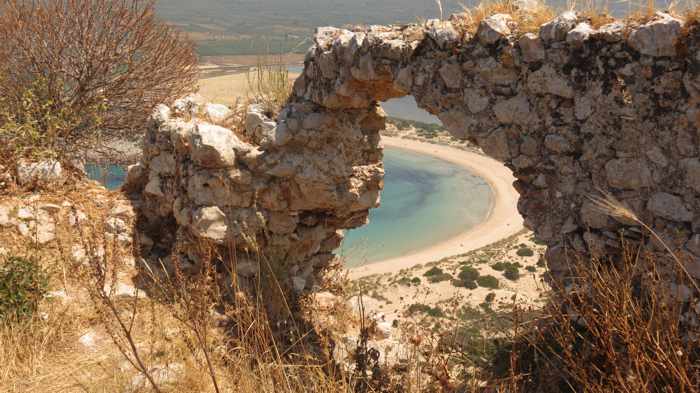
A hole in the castle wall gave us this first peek at Voidokilia bech
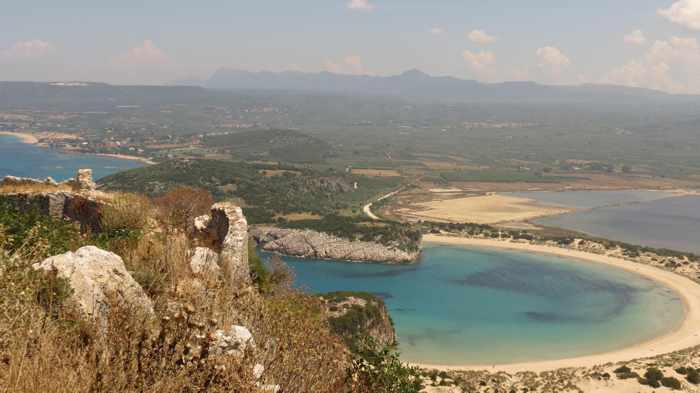
Castle view of Voidokilia beach. You can see more photos of the beach in my post A bucket list visit to Voidokilia
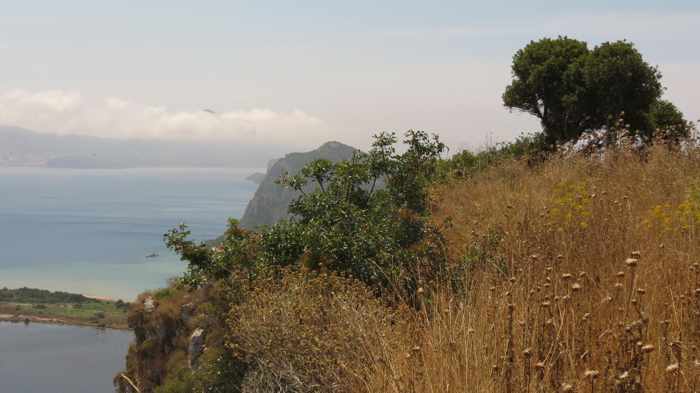
View in the direction of Pylos from our lookout point on the eastern wall
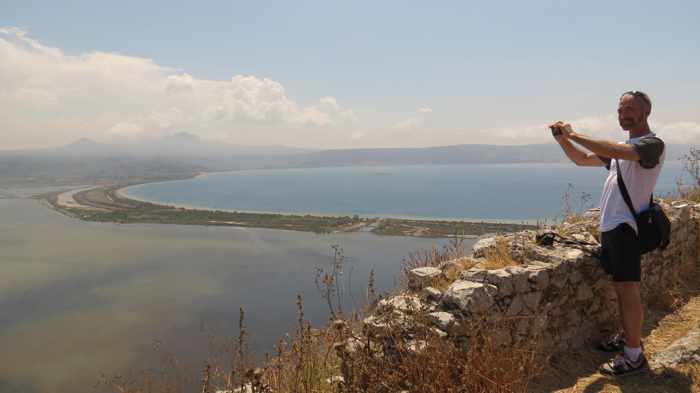
The Gialova lagoons and Navarino Bay spread out below me as I take photos of Voidokilia beach from the eastern wall of the castle
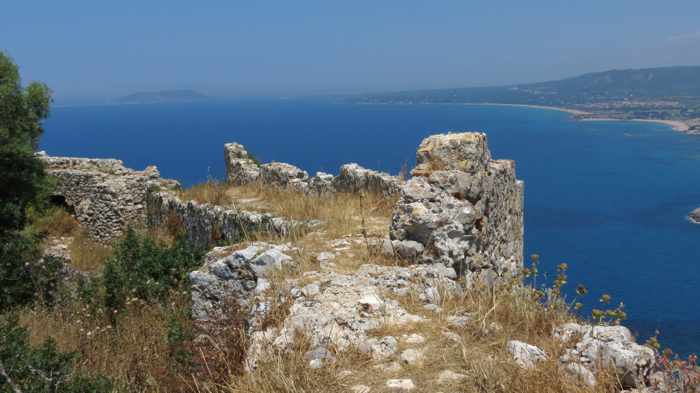
Castle wall view of the Ionian Sea and the Messenian coast to the north
Once we had finished taking photos and savouring the scenery, we agreed we had seen enough of the castle ruins — it was time to return to Divari beach. We found an easier way out of the north yard, but still had to clamber across boulders and loose stones in some areas before finally setting foot on sturdy ground. Glancing across the yard, I watched as two people climbed down from the west wall and tried to find a shortcut to reach the spot where we were standing. As they struggled to stay upright on the wobbly rocks, I couldn’t help but chuckle. “You’re really going to wish you had gone back to the end of the wall and taken the trail!” I remember thinking. I was so glad we weren’t the only people who had thought we could save a few minutes by cutting across the yard. At least six of us had made the same mistake, and I’m sure many others have done it, too.
To get back down the hill, we took a different path than the one we had walked to reach the castle entrance. This trail twisted through a lush green landscape of bushes and trees before joining the path we had come up. Although the climb to the castle had taken us well over 25 minutes, the descent to Divari beach took less than 20.
Was our castle trek worth the time and effort?
Except for the harrowing shortcut experience, I was glad we visited Palaiokastro. The wall walk was exciting, as was the opportunity to see Voidokilia from above. Would I recommend it to others? If you are adventurous, have good balance and an even better pair of hiking or athletic shoes, why not? If you don’t stray from the main paths or try to take shortcuts, the hike shouldn’t be too strenuous. Just watch your step and keep an eye on where you are headed, especially if you have to walk over piles of rock and stones. (You’ll encounter some on your way to the castle entrance and at a few places inside the fortress.) And don’t forget there is a good reason the castle is supposed to be “closed” — the real risk that stones could fall from the walls at any time, particularly in the entrance portal and on the walls.
If the trek sounds too intimidating, why not consider walking only as far as the castle walls, without attempting to climb through the entrance portal? It’s an interesting and relatively easy hike up and down, with beautiful sea and coastal scenery along the way. The centuries-old fortification walls of Palaiokastro look quite impressive when they first come into view in the distance, and it’s awe-striking to stand at the base of the imposing stone walls and imagine how formidable the stronghold must have appeared to approaching enemies. On the other hand, the castle interior is rather unremarkable, so I don’t think you miss much if you don’t go inside. Of course, you won’t be able to take a selfie with Voidokilia in the background if you don’t enter the Palaiokastro, but you also won’t have to worry about being blown off a wall, or spraining your ankle walking over slippery boulders.
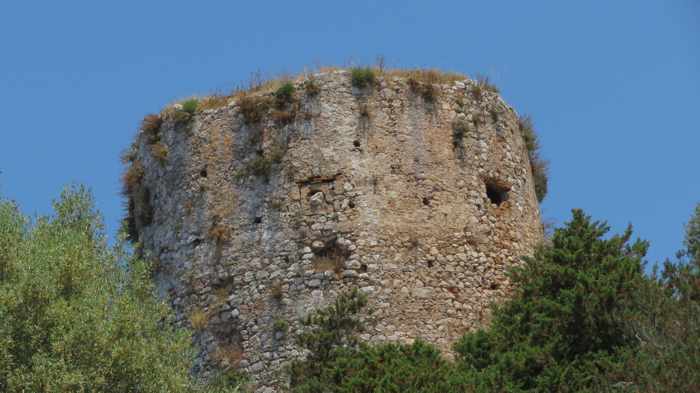
One of the castle’s round sentry towers
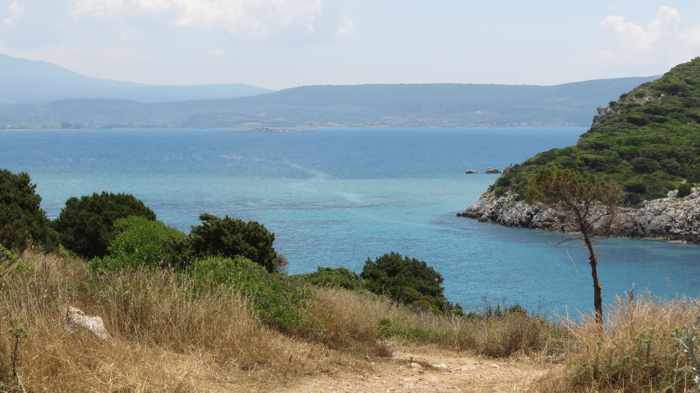
Navarino Bay comes into view during our walk down the hill. In about five more minutes, we would be back on Divari beach.
Here are links to several websites where you can find helpful information about Palaiokastro:
♦ The Palaiokastro page on Kastrologos Castles of Greece describes the history of the old Navarino Castle, and includes a photo gallery, maps, and a video
♦ Photos of the castle and a brief description of the two walking routes to it are provided in the Palaiokastro entry on the All Messenia travel website
♦ Maps, images and descriptions of walking routes are also shown on the Paliokastro page of the Voidokilia website
♦ The Pylos Travel in History site includes a description of Palaiokastro, several photos, and a video showing some of the marvellous views from the castle






0 Comments
2 Pingbacks